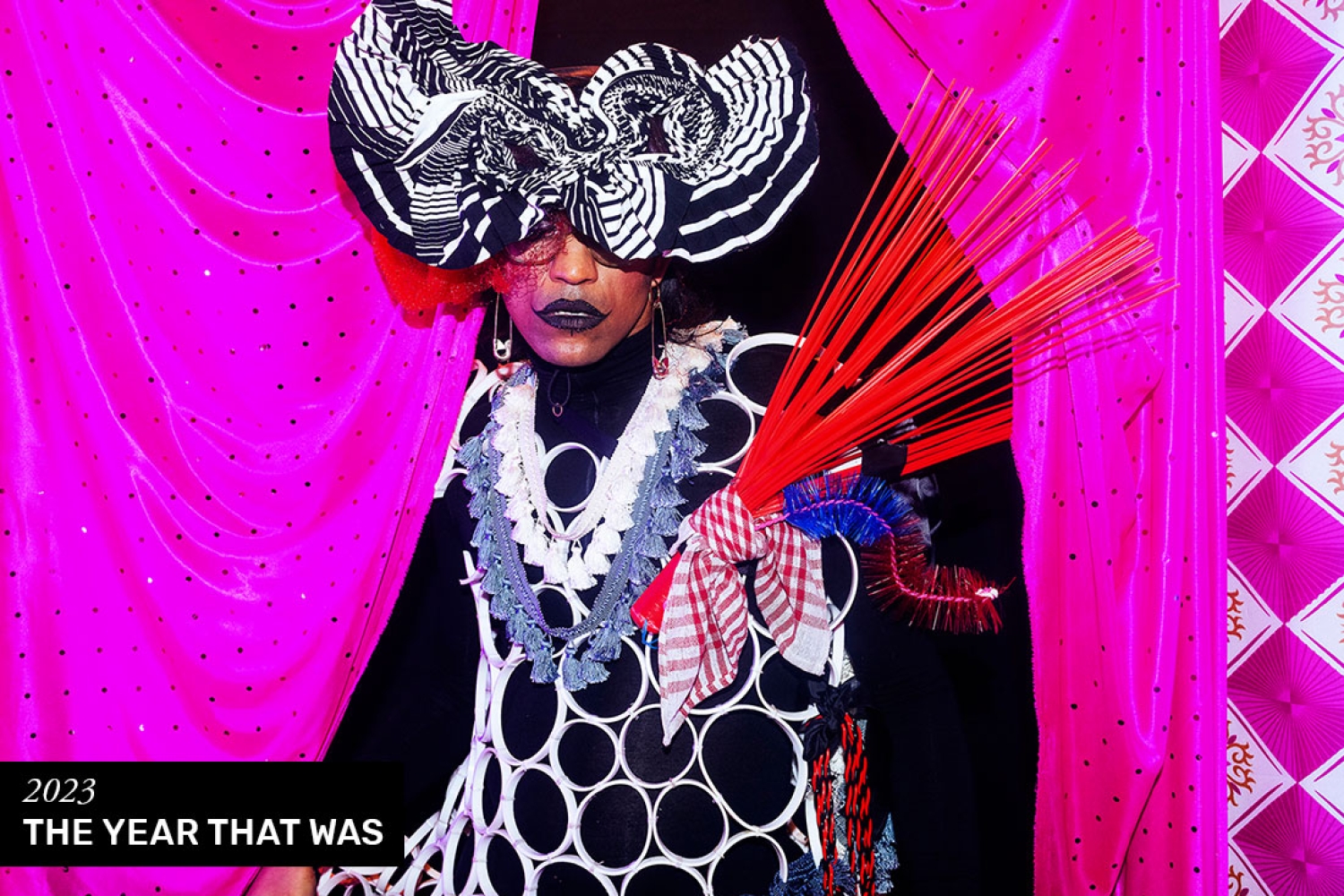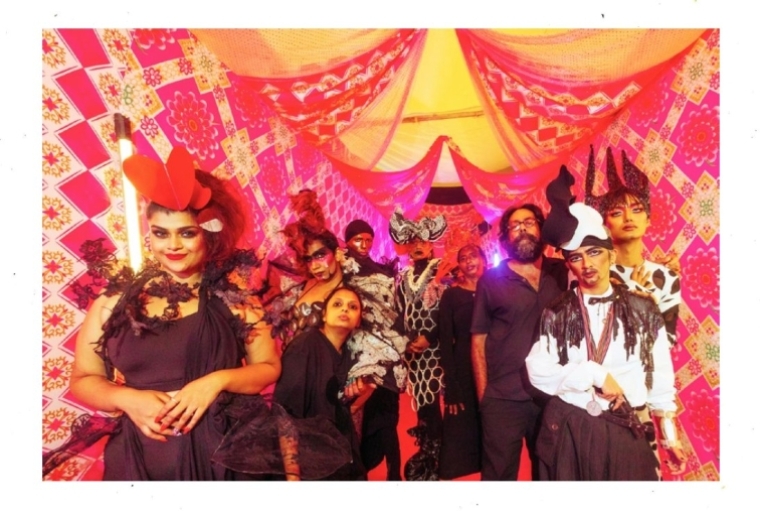

Intriguing, fascinating, trippy and avant-garde, HUM (we/ us) is a film that crosses boundaries and celebrates inclusivity in all its expressions. A confluence of various genres of the arts, be it fashion, film, music, and art, “HUM (we/ us) came out of an urgency to address, expose and challenge societal norms.” Artist Shilpa Chavan deconstructs the thought, vision and process behind her labour of love.
What inspired you to create this artwork in motion?
One of the most effective ways to reach an audience is through fashion. It has always been an observation of our times. But for a fashion project that endeavours to promote societal changes, a fashion presentation/show was not enough to share what I was thinking and brewing. It became a much larger ideology to convey. By amalgamating the worlds of fashion and film, I discovered a platform that is ever so fluid and can penetrate various milieus, territories, communities and dispositions without a scuffle. HUM (we/us) addressed the zeitgeist in a hybrid format that is still transmuting and evolving.
How did the entire crew get together?
The only criteria I had was creating a collaboration of like-minded humans with a single mission. Creativity as a solution. I started reaching out to people I had worked with earlier or with whom I wanted to create something. There were phone calls and Instagram DMs, and then some of the participants, be it actors or crew just somehow glided into this project. I randomly met some or it was a conversation or an introduction that led to building this incredible dream team. The cast has been chosen for who they are in their real lives. There is no act or pretence in the characters they play.
The protagonist, Humhu, identifies as a gender queer person. We have fashion models Subhiksha, Furquan, Souman, Gaurav, Sundraji, Ashish; an acid attack survivor - Daulat; Drag Queen – Glorious Luna; Drag Kings - Winnie and Gurleen; plus-size model – Payal; Hijras – Baby, Bijili, Shibani and television extras. All I was seeking at that point was a crew where each one came in as a part of a whole.
Sachin, our DOP, was only too excited! His hand- held camera experimentations and alluring imagery keeps us entranced all throughout. All the production, photography, equipment, crew, light boys, spot boys were all there, all thanks to Raman and Shona of Twism Design Productions. Their team smiled through all the commotion and we just moved forward one step at a time. Sonic came with his team from Mac Makeup and created all that beauty you see. Shine from Time Machine came with her hair team designing all the curls and hair bounces. Appurva just disappeared into the sets and captured some amazing images. Al Waling, who knows me only too well, wrote us the most appropriate film synopsis. Very eloquent, very Al; but lyrical enough so as to nudge you into my intermingling landscapes. Ashim did the sound design for the film. He composed some tracks specially for HUM(we/us) and we licensed a track from P.M. Tummala and Kangding Ray respectively. Finally, and above all, Tee was our BTS conjuror all along who made sure this magic happened! When I look back, the process seems seamless now.
Can you tell us a little about the costume design of the film as that in itself tells a story?
The costume design and styling has embedded symbolisms. I wanted to portray India in a neo-primitive meets avant-garde approach. A method of paradox that has always inhabited my design language. The entire film is colour-coded. Blue worn by the protagonist points to classism, blue collar, hierarchy, uniform and also a cold fragility and depression. Multi-coloured hues worn by the family and wedding guests, represent our multi-layered, biased society. A monochromatic tribe in black and white with splashes of red represent an ideology that is clear cut and straightforward, where red is thrown in for courage. The final dance in the film just sealed the deal for me, in a conversation about inclusivity and a utopian new world.
You have known Ashim since a while, what is it about his sensibility that connects with you? How did you decide what treatment to take with HUM (we/us)?
When I wrote and conceptualized HUM (we/us), there was no doubt that only Ashim was going to direct it. I wrote the script about ten years ago as a fashion film, talking about sustainability and DIY and repurposing; but after a decade, the ideas and thought processes have changed. We have waited a decade to bring this project to life. Aside from the fact that we are old friends, we share an old Bombay aesthetic.
The idea was to bring out a film that speaks of India from the underbelly of India. We never discussed any specific treatment. We didn’t need to. We both knew what wascoming from the other. It was a match of oeuvres. Even on set, we were just doing our respective jobs. When Ashim designed the sound, I knew it was going to be a hypnotic enticement that would slowly unravel the plot. Preparing to introduce an idea you’ve held together for years you sometimes find yourself at the very beginning of some- thing you cannot put a finger on. It just is.
What is it that you want the viewers to take away from this extremely evocative film?
This project for me was borderline activism where I wanted to propagate the idea of Unapologetic Self-Expression! It is an Exploration of Self, leading to a Representation of Self. In whatever format you choose. Confronting a considerable number of social issues, this film is the voice of an India and consequently a World Culture. When we say Inclusive, Fluid, Diverse it does not only mean gender but ticks a lot more boxes.

How has your experience been making HUM (we/ us) and what next?
HUM (we/us) is an absolute Labour Of Love! I am in awe and feel immense gratitude. HUM (we/us) is on its own journey and we, the participants, are following suit. The film has taught me the true meaning of what Community and Family means.
The entire film has been a pro-bono project where each one on that floor was there with blind faith and belief in what we were making. No one knew how it would turn out. Some didn’t even know what we were shooting. Ashim and I were just following our shot breakups, sometimes improvising along the way Experiencing the making of HUM (we/us) has pushed me even deeper into creating works in varied mediums. Sometimes it’s imperative to utilise varied mediums to articulate a certain thought or concept. I have always oscillated between the worlds of fashion and art and I will continue to do so. I have decided to blindly dive into the unknown from now on, as I’ve discovered that it is there, in the unknown, where the magic awaits you.
Ashim Ahluwalia’s Director’s Statement
I’ve known Shilpa for over twenty five years. We once talked about making a film together, and after so many years, here it is. She wanted to do a version of Cinderella, one featuring a tribe of outsiders shunned by society. A film about the difficulty of acceptance and inclusion. It also spoke to both of us as artists making work in a generally regressive environment where what we do is often impossible to define.
I re-imagined her idea as a hypnotic nightmare about an Indian Cinderella, who is employed as a servant in a oppressive household and dreams to go to the ball — in this case, a wedding, to which she is most certainly not invited. This film is a dystopian tropical fairytale full of unstable magic, about being left out of fashion, and how the most fashionable always remains the most handmade, the most personal. In this film, there is no beauty without despair. Oppression, anger, transformation, and glamour conspire, and yet, for all it’s dark insanity, the film offers hope at the end.
Words Shruti Kapur Malhotra
Photography Appurva Shah
Date 05-04-2023